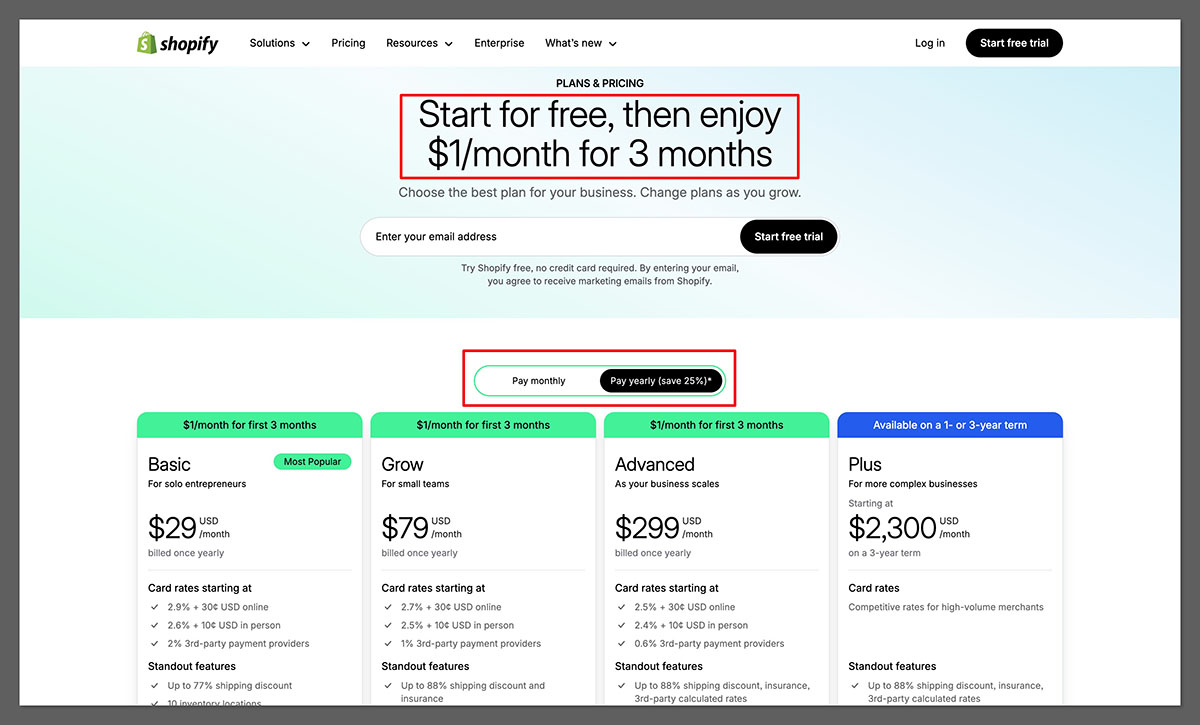Shopify and Etsy are two of the most popular platforms for starting a print on demand business. But which one should you choose?
After spending hundreds of hours analyzing how each platform performs for ecommerce sellers—especially those launching or scaling print-on-demand brands—I’ve put them head-to-head to give you the clearest possible recommendation.
Here’s the short version:
- Shopify – Best for long-term growth and brand-building
- Etsy – Best for quick setup and built-in audience
In this detailed comparison, I’ll walk through how Etsy and Shopify stack up across pricing, sales tools, branding capabilities, traffic potential, and more—so you can choose the best fit for your POD business.
Quick Comparison: Shopify vs Etsy for Print on Demand
Get a quick overview of how these two platforms compare:
| Feature | Shopify | Etsy |
|---|---|---|
| Best For | Brand growth, control, scalability | Beginners, built-in audience |
| Pricing | Starts at $39/month | $0.20 per listing + transaction fees |
| POD App Support | Excellent | Good, more limited |
| Traffic Strategy | DIY: SEO, ads, email, social | Built-in marketplace traffic |
| Customer Ownership | Full | Limited (Etsy owns the data) |
| Design Flexibility | Full customization | Minimal |
| Long-Term Potential | High (brand-focused) | Moderate (marketplace-reliant) |
This table is helpful if you’re just starting your research and want a broad overview.
For a deeper understanding of what each platform truly offers, keep reading as we break it down by category.
Best for Pricing and Profit Margins: Shopify Wins at Scale

If you’re just starting out, Etsy’s pricing model feels more accessible. There’s no monthly fee, and it’s easy to get your first few products live.
But those small transaction costs add up fast—especially as you scale.
Etsy’s Pricing Structure
Etsy charges you at several points during the selling process:
- $0.20 per product listing (renewed every 4 months)
- 6.5% transaction fee on the item price + shipping
- 3% + $0.25 payment processing fee (varies by country)
- 12–15% offsite ad fee (mandatory for sellers who make over $10K/year)
Total fee burden per sale can exceed 20% once ads kick in.
Etsy’s fee structure can be especially painful if you’re running a low-margin POD product or selling inexpensive items.
Many sellers are surprised to learn how little profit is left after the platform takes its cut.
Shopify’s Pricing Structure
Shopify has a flat monthly fee but no listing fees:
- Basic Shopify: $39/month — includes 2 staff accounts, basic reports, and standard checkout
- Shopify: $105/month — adds 5 staff accounts, professional reports, and better shipping discounts
- Advanced Shopify: $399/month — includes 15 staff accounts, advanced reporting, and third-party calculated shipping rates

Plus, you’ll pay:
- 2.9% + $0.30 per transaction (via Shopify Payments)
Shopify’s flat-fee structure rewards scale. As your order volume grows, your average cost per order drops, giving you a much clearer path to profitability.
Which One’s Cheaper?
| Platform | Monthly Cost | Transaction Fees | Hidden Costs |
|---|---|---|---|
| Shopify | $39+ | 2.9% + $0.30 | Add-on apps, ads |
| Etsy | $0 | 6.5% + $0.20 + ad fees | High-volume offsite ad fees |
If you’re doing fewer than 30 orders/month, Etsy might come out slightly cheaper.
But once you’re scaling or running ads, Shopify gives you more margin, flexibility, and control—without being penalized for growth.
If you’re planning to reinvest into growth through advertising or influencers, Shopify’s pricing gives you more breathing room.
That flexibility becomes critical when you’re optimizing your store for profit, not just revenue.
Best for Ease of Use: Etsy Wins for Simplicity

If you want to get started today, Etsy is hands-down the fastest and easiest.
Etsy: Built for Beginners
- Creating an account takes minutes
- No need to design a website
- Connect to Printful or Printify with a few clicks
- Launch products the same day
This makes Etsy a great option for testing new product ideas or learning the ropes of POD.
For sellers who aren’t tech-savvy or are intimidated by building a website, Etsy removes nearly all the friction.
It’s the quickest way to get your first product in front of buyers without needing to touch any code or design tools.
Shopify: More Involved Setup
- You’ll need to choose a theme, build pages, and set up shipping and taxes
- Customizing your store takes more time
- Connecting POD apps is straightforward, but requires a little more familiarity with ecommerce tools
Shopify isn’t hard to use—but it’s a full ecommerce platform, not a plug-and-play marketplace like Etsy.
That learning curve can feel steep initially, but Shopify’s onboarding flow and extensive help docs are solid. Once you’ve set it up once, managing the store is intuitive and repeatable.
Best for Branding: Shopify Is the Clear Winner
One of the biggest limitations with Etsy is how little control you have over your brand.
Etsy’s Branding Limitations
- You can add a shop banner and logo
- Product pages follow the same structure for every seller
- No custom checkout or branded experience
- Etsy controls the domain and customer journey
It’s functional—but every store looks and feels the same.
That sameness makes it harder to stand out unless your products are extremely niche or visually distinct. Shoppers may remember the product, but they rarely remember the brand.
Shopify Gives You Full Control
With Shopify, you can:
- Use your own domain name
- Customize your storefront completely
- Brand your email flows and thank-you pages
- Add upsells, bundles, and loyalty programs
- Run your own sales and campaigns
If you want customers to remember your store, Shopify is the better platform.
A strong brand creates long-term equity and defensibility. On Shopify, your store becomes a destination—not just a place to buy a t-shirt.
Best for Sales and Marketing Tools: Shopify Takes the Lead
Both platforms allow you to sell print on demand products. But Shopify’s ecommerce features are significantly more advanced.
Etsy’s Sales Tools
- Listing creation and product variations
- Discount codes and coupon settings
- Limited analytics
- No built-in cart recovery or upsells
- Forced participation in offsite ads if you earn $10K+/year
Etsy’s focus is on search-based discovery, not advanced marketing.
You’re essentially relying on Etsy’s traffic and hoping for repeat purchases through good reviews.
Beyond that, there’s very little infrastructure to nurture a customer journey or re-engage buyers.
Shopify’s Sales Tools
- Cart abandonment recovery
- One-click upsells and cross-sells
- Custom discount logic
- Gift cards, subscriptions, bundling apps
- Facebook, Instagram, TikTok, and Google integrations
- Shopify Email for automated campaigns
Shopify is built for sellers who want to run a full sales funnel—not just post a product and hope for traffic.
That means you can build systems that run while you sleep. Email flows, upsells, and post-purchase campaigns allow you to maximize every transaction.
Best for Traffic and Customer Data: Shopify Gives You the Edge
This is a critical difference between the two platforms.
Etsy Brings the Traffic, But Not the Relationship
You benefit from Etsy’s built-in search engine and buyer traffic, which is great when starting out.
But:
- Etsy owns the customer email
- You can’t retarget your audience
- Your shop can be shut down at any time
- You can’t build an email list or launch remarketing campaigns
This makes Etsy fragile. One policy update or algorithm change can impact your revenue overnight.
Over time, this lack of ownership becomes a bottleneck. You can’t grow a reliable customer base if you’re always starting from zero.
Shopify Puts You in Control
On Shopify, you bring the traffic. But you own the customer.
That means:
- Full access to customer data and email
- You can run retargeting ads
- You can set up flows in Klaviyo or Mailchimp
- You can increase lifetime value over time
While Etsy is better for discovery, Shopify is better for retention and repeat purchases.
Customer data is the backbone of modern ecommerce strategy. Without it, you can’t optimise for LTV, segment audiences, or make data-driven decisions.
Best for Print on Demand Integrations: Shopify Wins on App Ecosystem
Both Etsy and Shopify support the top POD platforms. But Shopify’s app store is more advanced.
Supported POD Services
| POD Provider | Shopify | Etsy |
|---|---|---|
| Printful | Yes | Yes |
| Printify | Yes | Yes |
| Gelato | Yes | Yes |
| SPOD | Yes | Yes |
| Apliiq | Yes | Yes |
Shopify lets you:
- Connect multiple POD apps
- Automate routing by location or product type
- Use personalization tools like Customily
- Access deep analytics with apps like BeProfit
Etsy integrations are typically limited to one app per shop and offer fewer custom workflows.
Shopify also allows for easier scaling when you want to diversify suppliers or automate different fulfillment paths. That operational flexibility becomes critical once your volume increases.
Best for Long-Term Growth: Shopify is the Best Choice
Here’s where Shopify truly shines. If your goal is to build a business—not just make quick sales—Shopify is the better foundation.
Etsy’s Growth Limitations
- You’re tied to a third-party marketplace
- You can’t scale paid ads effectively
- You don’t own your audience
- Algorithm changes can wipe out traffic
Etsy is fine as a side hustle or testing ground, but most serious sellers eventually move off the platform—or at least expand beyond it.
The ceiling on Etsy isn’t just about traffic—it’s about control. You’re always reacting to external forces rather than designing your own strategy.
Shopify Supports Scalable Growth
With Shopify, you can:
- Build out a full brand
- Run paid traffic with a real return on ad spend
- Optimize your funnel for LTV
- Expand into subscriptions, upsells, and wholesale
- Build an asset that can be sold or acquired
If you want to eventually grow beyond $5K/month, Shopify gives you the tools to do it predictably.
The platform is used by everyone from tiny side hustles to $100M+ DTC brands for a reason—it scales with you.
Final Verdict: Which Should You Choose?
Here’s how I’d summarize the decision based on experience:
| Goal/Need | Best Choice |
|---|---|
| Test products quickly | Etsy |
| Validate new POD designs | Etsy |
| Own the customer relationship | Shopify |
| Build a long-term brand | Shopify |
| Run paid ads and email marketing | Shopify |
| Start with no upfront budget | Etsy |
My advice? Use Etsy to validate. Use Shopify to scale.
Some sellers start on Etsy, find winning products, and then migrate to Shopify to take control.
Others launch on Shopify from day one and grow through SEO and social.
If you’re serious about building a long-term print-on-demand brand, Shopify is the better platform.
But if you’re brand new and want to keep it simple, Etsy is a great place to begin.
The right platform isn’t always about features—it’s about where you are and where you’re going. Choose the one that fits your current needs, while keeping your long-term goals in mind.






